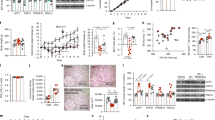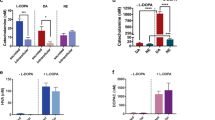Abstract
THYROTROPIN-RELEASING hormone, pyroglutamyl-histidyl-prolineamide (TRH, Fig. 1) belongs to the class of hypothalamic peptides termed releasing factors1. Although TRH was originally described as the hormone which stimulates the release of thyrotropin, it has subsequently been shown to be involved in many other biological processes1. The mechanism by which TRH exhibits this broad range of activities is not clear; it might involve the action of TRH at multiple recognition sites or TRH might serve as a precursor for compounds which are biologically active. Previous studies on TRH metabolism have demonstrated the formation of pyroglutamyl-histidyl-proline (acid TRH, Fig. 1)1. Attempts to associate biological activity with this compound have been uniformly negative, providing no support for the precursor hypothesis2,3. We show here that, in addition to acid TRH, TRH is also metabolised to histidylproline diketopiperazine (His-Pro, Fig. 1)4,5. This cyclic dipeptide is substantially more potent than TRH in reducing ethanol-induced sleep in rats6. These data indicate that TRH metabolism plays a part in its biological effects.
This is a preview of subscription content, access via your institution
Access options
Subscribe to this journal
Receive 51 print issues and online access
$199.00 per year
only $3.90 per issue
Buy this article
- Purchase on Springer Link
- Instant access to full article PDF
Prices may be subject to local taxes which are calculated during checkout
Similar content being viewed by others
References
Reichlin, S., Saperstein, R., Jackson, I. M. D., Boyd, A. E. & Patel, Y. A. Rev Physiol. 38, 389–424 (1976).
Vale, W., Grant, G. & Guillemin, R. in Frontiers in Neuroendocrinology, (eds Ganong, W. F. & Martini, L.) 375–413 (Oxford University Press, New York, 1973).
Prange, A. J., Jr et al. Life Sci. 16, 1907–1914 (1975).
Prasad, C. & Peterkofsky, A. J. biol. Chem. 251, 3229–3234 (1976).
Prasad, C. & Peterkofsky, A. Proc. Endocr. Soc. Mtg 58, 190 (1976).
Breese, G. R., Cott, J. M., Cooper, B. R., Prange, A. J., Jr & Lipton, M. A. Life Sci. 14, 1053–1063 (1974).
Doolittle, R. F. & Armentrout, R. W. Biochemistry 7, 516–521 (1968).
Noble, E. P., Wurtman, R. J. & Axelrod, J. Life Sci. 6, 281–291 (1967).
Breese, G. R., Cooper, B. R., Prange, A. J., Jr, Cott, J. M. & Lipton, M. A. The Thyroid Axis, Drugs and Behavior (ed. Prange, A. J., Jr) 115–127 (Raven, New York, 1974).
Dawson, R. M. C., Elliott, D. C., Elliott, W. H. & Jones, K. M. (eds) Data for Biochemical Research, 229 (Clarendon, Oxford, 1959).
Author information
Authors and Affiliations
Rights and permissions
About this article
Cite this article
PRASAD, C., MATSUI, T. & PETERKOFSKY, A. Antagonism of ethanol narcosis by histidyl-proline diketopiperazine. Nature 268, 142–144 (1977). https://doi.org/10.1038/268142a0
Received:
Accepted:
Issue Date:
DOI: https://doi.org/10.1038/268142a0
This article is cited by
-
Focus on cyclo(His-Pro): history and perspectives as antioxidant peptide
Amino Acids (2008)
-
Low doses of TRH in amyotrophic lateral sclerosis and in other neurological diseases
The Italian Journal of Neurological Sciences (1991)
-
Effects of thyrotropin releasing hormone on human sudomotor and cutaneous vasomotor activities
European Journal of Applied Physiology and Occupational Physiology (1988)
-
Is all cyclo(His-Pro) derived from thyrotropin-releasing hormone?
Neurochemical Research (1987)
-
Mechanism of antidepressant and learning-stimulating effects of thyrotropin releasing hormone and its analogs
Bulletin of Experimental Biology and Medicine (1986)
Comments
By submitting a comment you agree to abide by our Terms and Community Guidelines. If you find something abusive or that does not comply with our terms or guidelines please flag it as inappropriate.



